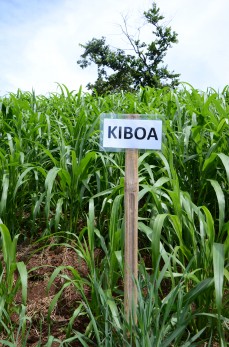Adlai grass (Coix lacryma-jobi L.), more commonly known in English as Job’s tears, has proven an agricultural success at the SANREM LTRA-12 site in Mindanao, the Philippines in plot experiments that occurred in July 2012.
Initially pioneered by the Bureau of Agricultural Research of the Philippines (BAR), adlai studies were the focus of BAR research initiatives conducted in 2010 with NGO partners Earthkeepers and MASIPAG, a consortium of farmers and other agri-focused individuals.
And by all accounts adlai continues to be a very promising crop in the future food system of Southeast Asia.

The Kiboa variety of adlai grass performed the best of the three tested in Claveria yielding 3.5 tons per hectare of grain. Image: Adrian Ares
The SANREM-CRSP has recently tested several different varieties of adlai grass for CAPS as a substitute to rice and maize in the Mindanao region at our research site in Claveria.
Common in Southeast Asia, adlai is particularly appealing from a conservation agriculture production systems (CAPS) perspective because the plant produces a large amount of biomass that can be used as mulch to control weeds and mitigate soil erosion on sloping uplands. Another hallmark of adlai grass as a climate-smart crop is its long rootstock which can grow up to 150 cm. The long rootstock serves as a biopump to absorb excess water, which also deters erosion, and provides nutrients to the plant. Unlike its botanical relatives in the maize and rice family, adlai can also be harvested up to three times per year. Increased harvest seasons combined with the ability to withstand the torrential rain showers of its tropical locale (and conversely thrive in times of drought), as well as adlai’s persistence in growing in acid sloping uplands of the southern Philippines, make adlai grass a crop of the “bionic” kind.
“This endemic species is good as food for humans and feed for livestock, as well as mulch in order to suppress weeds, reduce surface water evaporation as well as improving soil organic matter (soil C),” said ICRAF Research Manager for Mindanao and SANREM CRSP Claveria Research Site Coordinator, Agustin Mercado, Jr.
Three adlai varieties were tested in research plots at Claveria: Kiboa, Ginampay and Tapol. Kiboa produced the highest grain yield of 3.5 tons per hectare and a total dry matter yield (TDMY) of 8.8 tons per hectare, followed by the Ginampay variety with a grain yield of 3.0 tons per hectare and a TDMY of 7.4 tons per hectare. The Tapol variety was the poorest performer.
But adlai goes beyond serving as only a food crop. Many believe the grains of adlai grass to have medicinal properties. It is commonly used as a folk remedy for a wide range of ailments that run the gamut from the quotidian headache to stomach ailments.
On a less serious note, it’s also not uncommon to see adlai grains crafted into decorative jewelry. When the grains are dried, their rounded shapes are easily strung together as bracelets and necklaces making this grain the ultimate multipurpose crop that is at home in the kitchen, medicine cabinet and jewelry box.

